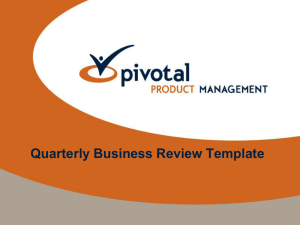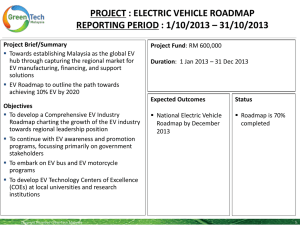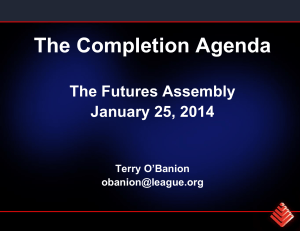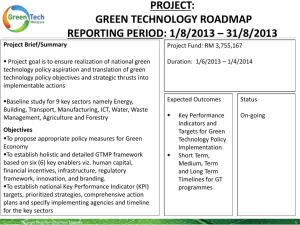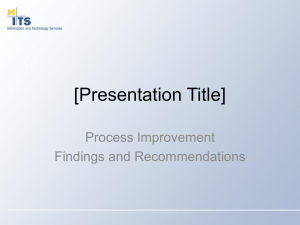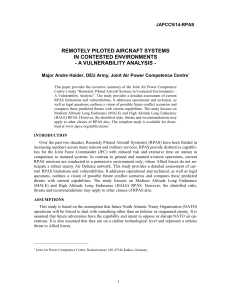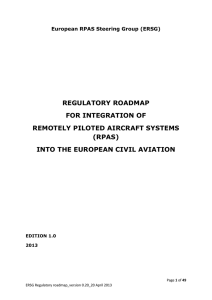Outcome from the UAS Panel Process
advertisement
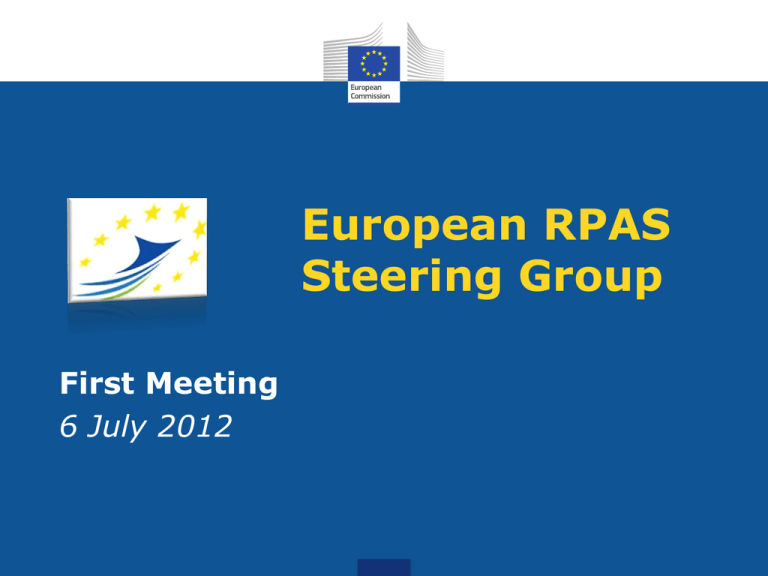
European RPAS Steering Group First Meeting 6 July 2012 Agenda Welcome and opening 1.Outcome of the UAS Panel Process 2.Objectives and description of the ERSG 3.Structure and main content of the Roadmap 4.Roadmap definition working arrangements. 5.Adoption of the Terms of Reference 6.Preliminary discussion on the Roadmap and contribution from the ERSG members AOB 2 1 Outcome of the UAS Panel Process 2 Objectives and description of the ERSG 3 Structure and main content of the Roadmap 4 Roadmap definition working arrangements. 3 3 The UAS Panel Process • Consultation process made of 5 workshops Industry and Market (UVSI) Air space Insertion and Radio Frequencies (ECTL) Safety (EASA) Societal Dimension (Prof. Roma) R&D (EDA) • Discussion Papers and Conclusions available at http://ec.europa.eu/enterprise/sectors/aerospace/uas/index_en.htm 4 Commission Staff Working Paper • EC will issue a SWP Summarizing the conclusions of the UAS Panel Process Providing a common understanding on the issues at stake and the actions needed To be issued in July 5 Conclusions of the UAS Panel • Great potential justifying EC support Active contribution from industry Important civil applications & market potential (jobs & growth) • Barriers identified Air Traffic Insertion is urgent and complex Others like insurance, privacy, public acceptance 6 Conclusions of the UAS Panel (2) • Call for an initiative led by the European Commission to reinforce coordination between all European actors, to identify a common roadmap toward a progressive insertion, to "institutionalise" the process. 7 Commission follow-up to UAS Panel Setting-up a European RPAS Steering Group ERSG to provide a framework to enhance the coordination of the activities necessary to achieve the initial safe insertion of all type of RPAS into the European air traffic progressively from 2016 to contribute to the development of harmonized rules for all RPAS in Europe, including for those with a take-off mass below 150kg currently falling under national competency. 8 1 Outcome of the UAS Panel Process 2 Objectives and description of the ERSG 3 Structure and main content of the Roadmap 4 Roadmap definition working arrangements. 9 9 Objective of the ERSG "Foster the development of civil RPAS by planning and coordinating all the activities necessary to achieve the initial safe insertion of RPAS into the European air traffic by 2016" (ToR p2) Objective to be achieved by Identifying all the activities to be performed to reach the objective Coordinating the activities and stakeholders in the most efficient way contributions of all Monitoring the progress towards the objective 10 ERSG working method (1) "The ERSG will be responsible for developing and monitoring the implementation of a comprehensive Roadmap setting the milestones, the distribution of tasks among the stakeholders and the timing for the insertion of RPAS in the European airspace" (ToR p2) The Roadmap will be the main tool of the ERSG: The ERSG will adopt the Roadmap and its periodical updates. Doing so, each organisation will commit his organisation to the tasks agreed in the Roadmap. The ERSG will also be the place where to solve any potential issue concerning the definition and implementation of the Roadmap. 11 ERSG working method (2) "The ERSG will be responsible for developing and monitoring the implementation of a comprehensive Roadmap setting the milestones, the distribution of tasks among the stakeholders and the timing for the insertion of RPAS in the European airspace" (ToR p2) The ERSG will set-up appropriate working arrangements to establish and update periodically the Roadmap; ensure a proper monitoring of the work linked to its implementation. 12 Condition for success "The success of this initiative will heavily depend on the commitment of all organisations and industries involved, to cooperate in achieving the objectives set by the ERSG and their willingness to contribute with own resources and technical expertise to the work necessary to reach RPAS ATI" within the agreed timeline (ToR p2) Commitment of each member to contribute to the work with own resources and expertise coordinate its activities with the others comply with the agreed decisions adopted in the roadmap 13 Membership of the ERSG "The European RPAS Steering Group is composed of organisations/groups representing the main European stakeholders involved in RPAS, experts in the area and the relevant Commission services. (ToR p3) Coordination process based on the good-will and trust of participants (cfr "Open Method of Coordination") Need to involve representatives of the main organisations involved in the work (regulatory, research, etc) to be performed to achieve RPAS ATI Open to additional participation if deemed necessary (research centres?) 14 Additional objectives The ERSG could have additional objectives if found useful, like maintaining an overall coordination with international bodies like FAA ???? 15 1 Outcome of the UAS Panel Process 2 Objectives and description of the ERSG 3 Structure and main content of the Roadmap 4 Roadmap definition working arrangements. 16 16 Structure of the Roadmap (1) One Roadmap with 3 areas of activities wellcoordinated Regulatory Research and development Complementary measures Liability / insurance Privacy/ data protection Public perception 17 Structure of the Roadmap (2) … and 2 level of details an overall vision Providing a complete high level planning tool, towards full insertion of all type of RPAS Setting priorities and intermediate milestones Identifying quick wins Missing in Europe until now A detailed rolling work plan for each of the 3 areas Allowing close coordination of all activities Over the next 2/3 years To be updated on a yearly basis 18 Content of the Roadmap (1) The Regulatory work plan should include A detailed planning of all the regulatory deliverables to be developed with the contribution of the relevant stakeholders (Eurocontrol, EUROCAE, JARUS) under EASA's leadership Including all activities needed to put in place common rules for RPAS > 150 kg and Make available harmonized rules for RPAS < 150 kg 19 Content of the Roadmap (2) The R&D work plan should include A detailed technology development plan coordinated with the regulatory work Proposals on the required instruments to implement the R&D effort In order to assess the possibility to support some of this work through the Horizon 2020, EC needs by September ? : a clear indication concerning the preferred R&D instrument (stand-alone JTI, SESAR extension, open calls, etc) by October ? a first priority list of technology developments? 20 Content of the Roadmap (3) The work plan on complementary measures Should analyse and provide recommendations on issues linked to Liability / insurance Privacy : data protection Should propose measures to increase public acceptance of RPAS 21 Deadlines The following deadlines are proposed: A first issue of the Roadmap should be available by end of the year A more detailed version developed in the course of 2013 Then the roadmap should be updated on a yearly basis. 22 1 Outcome of the UAS Panel Process 2 Objectives and description of the ERSG 3 Structure and main content of the Roadmap 4 Roadmap preparation 23 23 Basic principles The following rules drive the preparation of the Roadmap Every ERSG member is free to contribute to each of the 3 areas of the Roadmap Each ERSG member is expected to contribute in areas where he has prominent competency Inputs from other sources may also be included when relevant (research centres, ULTRA project) 24 Working arangements • Proposed working arrangements The ERSG will appoint 3 rapporteurs (1 per area) The ERSG members are invited to nominate experts from their organisation in any of the 3 area to work with the rapporteur Rapporteurs will deliver the draft roadmap to an Integration Team (EC + Rapporteurs) The Integration Team will ensure completeness and coordination of the roadmap deliver it to the ERSG for adoption 25 Board ERSG Deputy – Director Director General ENTR MOVE ECAC JARUS SESAR ASD ESA EDA ECTL EASA RTD UVSI ad-hoc EUROCAE expert Working Level Roadmap Integration Team ENTR D4 MOVE E2 MOVE E3 R O A D M A P RTD H3 Raporteur Raporteur Raporteur Experts (Regulation & RF) Experts (R&D) Experts (Complementary measures) Other services 26 Nominations (1) • Proposed Rapporteurs Regulatory EASA: Filippo Tomasello R&D SESAR JU: Michael Standar Complementary measures Professor Alfredo Roma 27 Nominations (2) • Members of the Working Groups Each members of the ERSG are invited to nominate experts to at least one WG. The coordinates of the nominated experts should be sent at ENTR-UAS@ec.europa.eu before 18 July. 28


